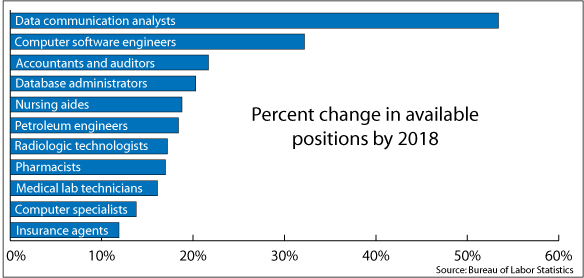Job Retraining Programs Are Revving Up
Which jobs will grow the fastest in the years ahead? And who’s doing what to teach jobless workers new skills?

Believe it or not, there’s a growing disconnect in the American labor force: On the one hand, the average length of unemployment stands at a record 40 weeks, with more than 4 million Americans out of work for a year or longer. On the other hand, many employers are desperate to hire more workers—provided they have the necessary skills.
Take Mobile, Ala., as an example. The metropolitan area has an 11% unemployment rate, yet a whopping 7,000 skilled welding jobs and 1,200 industrial maintenance positions remain unfilled.
Among other hard-to-fill jobs: Computer engineers. Medical lab technicians. Radiologic technologists. Pharmacists. Automotive service technicians. Accountants. Auditors. Pharmacists. And insurance sales agents.
From just $107.88 $24.99 for Kiplinger Personal Finance
Become a smarter, better informed investor. Subscribe from just $107.88 $24.99, plus get up to 4 Special Issues

Sign up for Kiplinger’s Free Newsletters
Profit and prosper with the best of expert advice on investing, taxes, retirement, personal finance and more - straight to your e-mail.
Profit and prosper with the best of expert advice - straight to your e-mail.
Adding to the disconnect: People aren’t as mobile as they once were. The sluggish housing market makes it hard to sell and move to an area with stronger job prospects. For example, Nevada has a surplus of nurses, while New York City and Philadelphia both have shortages.
So with people less able and willing to move to fill needed jobs, retraining workers for skilled positions in their current hometowns is gaining greater urgency.

To meet the needs, the public and private sectors are teaming up in a variety of innovative ways.
Here are some leading examples.
State Programs
New Hampshire’s Return to Work program gives unemployed workers the opportunity to take a job to learn new skills while still receiving unemployment benefits. Georgia Works offers a similar option to residents of that state. Participating companies have no obligation to hire the trainees, but they must have unfilled positions to participate in the program. Both programs offer jobless workers the chance to gain skills, and employers the opportunity to test out potential employees.
Delaware, Maine, Maryland, New Jersey, New York, Oregon and Pennsylvania, meanwhile, provide assistance to unemployed workers who want to start their own businesses. To qualify for such assistance, people must first be eligible for unemployment insurance under their states' laws.
Uncle Sam
Congress just renewed the Trade Adjustment Assistance program to the tune of $575 million to provide aid to workers who have been displaced because of foreign competition. In addition to helping such workers retrain for new jobs, the renewal will cover 90% of job search or relocation costs, up to $1,250.
The Department of Labor has joined forces with Facebook to create the Social Jobs Partnership, a service that will use the social networking site to aggregate a variety of job search options offered through the government and the private sector.
Nearly 90% of companies have used social networking as a recruiting tool this year, up from 83% last year, according to a study conducted by Jobvite. Look for the partnership to extend to other social networking sites such as LinkedIn. Although the program doesn’t assist with training, it does offer a centralized location for job seekers to begin their search online.
Moreover, the Department of Labor’s One-Stop Careers Centers, available at 3,000 locations nationwide, are designed as drop-in centers with employment counselors to assist those seeking employment. Counselors can also direct unemployed workers to job training programs. Employers can work with the centers for help in targeting ideal candidates.
Public-Private Initiatives
Boeing has teamed up with Trident Technical College and readySC in South Carolina to create a curriculum specifically to funnel local residents into jobs at the new plant in Charleston designed to build the jet company's 787 Dreamliner.
Lockheed Martin is working with a group of community colleges in Texas to help train workers for aerospace jobs.
And Vanguard Integrity Professionals, the Nevada-based security software firm, is running a series of programs throughout the country and online to train people on changes in technology. The company also provides unemployed cybersecurity professionals with scholarships to attend training conferences.
On a related note, look for more community colleges, long a bastion of retraining, to join with public universities to leverage funds reduced by state budget cuts. One such example: Ohio’s Lorain County Community College and Ohio State University offer a joint program in welding.
Nonprofit Involvement
Experience Works places low-income unemployed workers over 55 years old with community service organizations, where they can work part time and gain new skills. Wages are paid through grants from Experience Works. Assignments range from working as a cashier at a Salvation Army store to serving as an organizer at a local food bank. Skills gained in such positions are transferable to full-time jobs.
Jobs for the Future helps high school students earn vocational education credit before graduating, helping them prepare to enter the workforce or graduate college in less time. The Pathways Out of Poverty program works in Chicago, Detroit, Los Angeles, Milwaukee and Philadelphia to help unemployed workers find work in the emerging green sector.
Single Stop USA, a nonprofit run out of New York City, is working with the Association of Community College Trustees to embed counseling centers at community colleges throughout the country. The centers employ a software system that evaluates different aspects of people's financial and educational situation, helping them determine whether they’re eligible for education grants or training assistance that they weren’t aware of. The pilot program is currently available at fewer than 10 schools but will be expanding to more locations over the next several years.
For-Profit Schools
For-profit and private sector schools run the gamut -- offering training courses and certification for occupations ranging from hair stylists to medical technicians. Enrollment at for-profit schools has grown by 94% over the past six years because of demand, an increase in online options and the opening of more schools.
Note that for a for-profit to win national accreditation, it must demonstrate a track record of placing 70% of its graduates in a job in their field of study within six months of graduation. Prospective students should check with a school’s employment center to find out which companies routinely recruit at the school and where its graduates are working. And be sure to compare prices to find the best deal and ask about scholarship opportunities.
Profit and prosper with the best of Kiplinger's advice on investing, taxes, retirement, personal finance and much more. Delivered daily. Enter your email in the box and click Sign Me Up.

-
 Is Mechanical Breakdown Insurance Better Than an Extended Car Warranty?
Is Mechanical Breakdown Insurance Better Than an Extended Car Warranty?More insurers are starting to offer mechanical breakdown insurance to new car owners. What is it and should you buy it?
-
 What to Do When You Bank Lowers Your APY
What to Do When You Bank Lowers Your APYWhy banks lower APYs, options you can explore when it happens and whether more rate cuts are on the horizon.
-
 Forget Financial Forecasts: Focus on These 3 Goals for Success
Forget Financial Forecasts: Focus on These 3 Goals for SuccessWe know the economy is unpredictable and markets will do what they do, no matter who predicts what. Here's how to focus on what you can control.
-
 The Kiplinger Letter's 10 Forecasts for 2026
The Kiplinger Letter's 10 Forecasts for 2026The Kiplinger Letter Here are some of the biggest events and trends in economics, politics and tech that will shape the new year.
-
 Disney’s Risky Acceptance of AI Videos
Disney’s Risky Acceptance of AI VideosThe Kiplinger Letter Disney will let fans run wild with AI-generated videos of its top characters. The move highlights the uneasy partnership between AI companies and Hollywood.
-
 AI Appliances Aren’t Exciting Buyers…Yet
AI Appliances Aren’t Exciting Buyers…YetThe Kiplinger Letter Artificial intelligence is being embedded into all sorts of appliances. Now sellers need to get customers to care about AI-powered laundry.
-
 What to Expect from the Global Economy in 2026
What to Expect from the Global Economy in 2026The Kiplinger Letter Economic growth across the globe will be highly uneven, with some major economies accelerating while others hit the brakes.
-
 The AI Boom Will Lift IT Spending Next Year
The AI Boom Will Lift IT Spending Next YearThe Kiplinger Letter 2026 will be one of strongest years for the IT industry since the PC boom and early days of the Web in the mid-1990s.
-
 Amid Mounting Uncertainty: Five Forecasts About AI
Amid Mounting Uncertainty: Five Forecasts About AIThe Kiplinger Letter With the risk of overspending on AI data centers hotly debated, here are some forecasts about AI that we can make with some confidence.
-
 Worried About an AI Bubble? Here’s What You Need to Know
Worried About an AI Bubble? Here’s What You Need to KnowThe Kiplinger Letter Though AI is a transformative technology, it’s worth paying attention to the rising economic and financial risks. Here’s some guidance to navigate AI’s future.
-
 Will AI Videos Disrupt Social Media?
Will AI Videos Disrupt Social Media?The Kiplinger Letter With the introduction of OpenAI’s new AI social media app, Sora, the internet is about to be flooded with startling AI-generated videos.